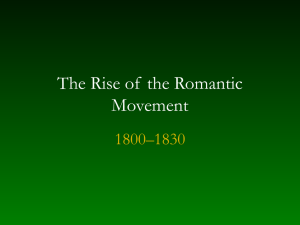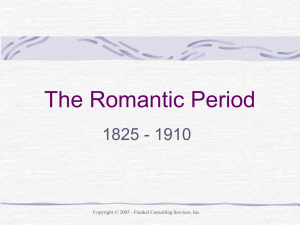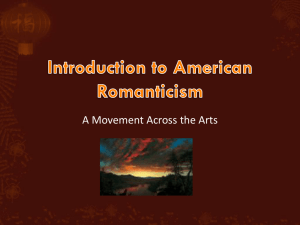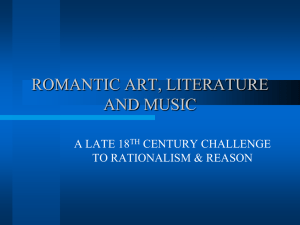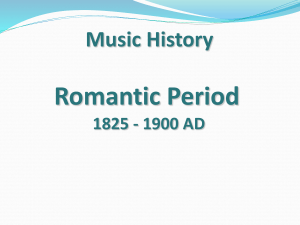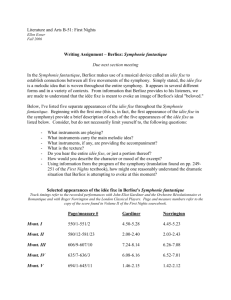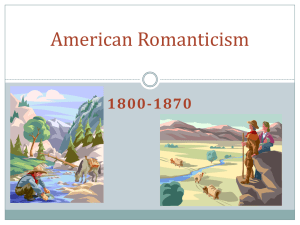File - SDC music resources
advertisement
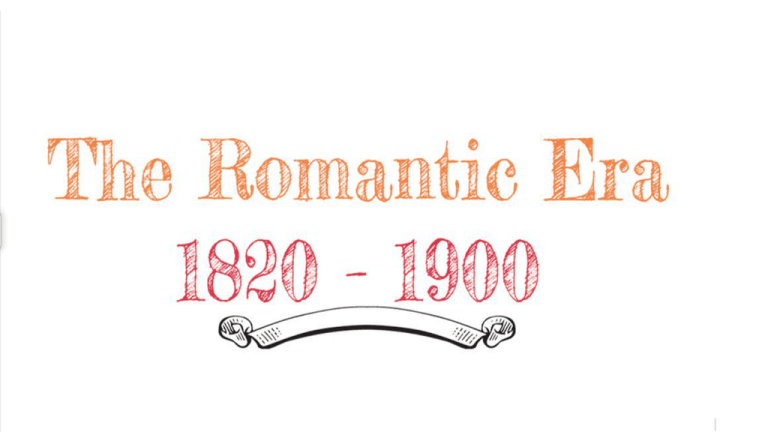
Romantic Era Mood Texture Instruments Dynamics Classical Era Ludwig van Beethoven is considered to be the composer who effectively ends the Classical Period and begins the Romantic Era. The works of his Middle and Late Periods dramatically differ from his early works in both structure and character, culminating with the monumental Symphony No. 9 in D minor, known as the “Choral” Symphony. Composers who continued the tradition of the Classical Period at the height of Beethoven’s career include Peter Winter, Anton Reicha, Muzio Clementi, and the famous German opera composer Carl Maria von Weber. Italian opera of the early 19th century initially resisted the trends of Romantic tendencies. However, composers such as Gioachino Rossini, Gaetano Donizetti, and Vincenzo Bellini continued Italian opera’s dominance through their innovations in both opera seria and opera buffa. A contemporary of Beethoven, Franz Schubert is known for his monumental output, most especially for his lieder, or German song, compositions, for their everchanging harmonies, textures, and flowing vocal lines. Paris in the early Romantic Period became the center of Europe’s musical scene with the development of grand opera, led by composers such as Giacomo Meyerbeer. His treatment of the orchestra would be echoed by later composers, including Hector Berlioz, Richard Wagner, and Richard Strauss. The 19th century was also a showcase for virtuoso performers. Composers and instrumentalists such as Niccoló Paganini, Franz Liszt, and Frédéric Chopin dazzled audiences with their musical prowess, usually performing their own compositions. The Romantic movement also saw the rise of programmatic music, or instrumental music that tells a definite story. Its main pioneer was the French composer Hector Berlioz, whose works inspired an entire generation of future orchestral composers. Richard Wagner was the most influential German opera composer of the 19th century, using mythological librettos to create grand works designed to promote German nationalism. He also pioneered the use of the leitmotif, or “leading motive”, a technique used to serve as a musical representation of a character, event, or feeling associated with the emotional content of the drama. http://www.youtube.com/watch?v=xeRwBiu4wfQ The Ride of the Valkyries is the popular term for the beginning of Act III of Die Walküre, the second of the four operas by Richard Wagner that constitute Der Ring des Nibelungen. The main theme of the Ride, the leitmotif labelled Walkürenritt, was first written down by the composer on 23 July 1851. The preliminary draft for the Ride was composed in 1854 as part of the composition of the entire opera, which was fully orchestrated by the end of the first quarter of 1856. Together with the Bridal Chorus from Lohengrin, the Ride of the Valkyries is one of Wagner's best-known pieces. In the opera house, the Ride, which takes around eight minutes, begins in the prelude to the Act, building up successive layers of accompaniment until the curtain rises to reveal a mountain peak where four of the eight Valkyrie sisters of Brünnhilde have gathered in preparation for the transportation of fallen heroes to Valhalla. As they are joined by the other four, the familiar tune is carried by the orchestra, while, above it, the Valkyries greet each other and sing their battle-cry. Apart from the song of the Rhinemaidens in Das Rheingold, it is the only ensemble piece in the first three operas of Wagner's Ring cycle. Outside the opera house, it is usually heard in a purely instrumental version, which may be as short as three minutes Before the 19th century, instrumental music consisted mostly of what is known as absolute music, or music that can be described simply from its form or structure. It is meant to exist solely for its own sake, and does not conjure up specific images designed by the composer or any external source. Although composers experimented with musical imagery before Romanticism, composers had not written instrumental music to tell a definite story. Musical imagery served more to convey general impressions to the listener, such as in Vivaldi’s Four Seasons quartet. With the emphasis on literary and highly charged emotional content, composers of the Romantic era began to write works that were based on specific literary references, specifically from the writings of Shakespeare and many others. Program music, is labeled specifically as instrumental works without vocals that tell a definite story that goes beyond mere musical impressions or imagery. Over the course of the century, composers from all over Europe would write programmatic works, mostly based on literary or folk tales of a nationalistic idiom. Among them would include Tchaikovsky The Nutcracker Suite. However, the first composer to bring program music to the forefront of the Romantic movement was the French composer, conductor, and writer Hector Berlioz (1803-1869). http://www.youtube.com/watch?v=zijlumzbJSI 1. How old was Berlioz when he completed his music studies? 2. How did people respond to Berlioz? 3. How did he describe his Symphonie Fantastique? Berlioz became the leading symbol for French Romanticism after rising to the forefront of orchestral music in the 1840’s. This is particularly evident in his first major symphony, the Symphonie Fantastique, Op. 14. During this time, Berlioz was deeply in love with the Irish actress Harriet Smithson, who became his muse for the idée fixe, or main idea that pervades the piece. In the symphony, the artist (Berlioz) is in the throngs of “hopeless love” and poisons himself with opium. The resulting hallucinations result in the five movements of the piece. http://www.bbc.co.uk/schools/gcsebitesize/musi c/western_tradition/programme_music1.shtml Another short berlioz video: http://www.youtube.com/watch?v=3oUVEFMLT LY For wordle 1800's 1800's 1800's 1800's 1800's 1800's 1800's 1800's 1800's 1800's 1800's Romantic Romantic Romantic Romantic Romantic Romantic Romantic Romantic Romantic Romantic Romantic Romantic Romantic Romantic Romantic Romantic Program Music Program Music Program Music Program Music Program Music Program Music Program Music Piano Piano Piano Piano Piano Piano Piano Piano Piano Chopin Chopin Chopin Chopin Chopin Chopin Chopin Chopin Liszt Liszt Liszt Liszt Liszt Liszt Liszt Liszt Liszt Berlioz Berlioz Berlioz Berlioz Berlioz Berlioz Berlioz Berlioz Berlioz Berlioz Berlioz Berlioz Berlioz Berlioz Berlioz Expression Expression Expression Expression Expression Emotion Emotion Emotion Emotion Emotion Emotion Emotion Individuality Individuality Individuality Nationalism Nationalism Nationalism Opera Opera Opera Opera Opera Opera Opera Opera Opera Beethoven Beethoven Beethoven Beethoven Beethoven Beethoven Beethoven Beethoven Beethoven Beethoven Beethoven Symphony Symphony Symphony Symphony Symphony Wagner Wagner Wagner Wagner Wagner Wagner Wagner Wagner Wagner Lied Lied Lied Lied Lied
